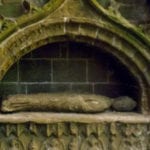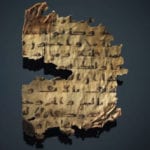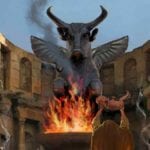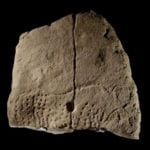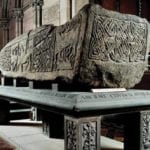 Weird Stuff
Weird Stuff  Weird Stuff
Weird Stuff  Mysteries
Mysteries 10 Tragic Disappearances and Deaths in Joshua Tree National Park
 History
History 10 Ways Childhood Really Sucked in the Old West
 Music
Music 10 Name Origins of Famous Bands from the 1990s
 Religion
Religion 10 Biggest Turnarounds by the Catholic Church
 Weird Stuff
Weird Stuff 10 Unbelievable Times Laws Had Unintended Consequences
 Humans
Humans Ten Historic Women Who Deserve Way More Credit Than They Got
 Movies and TV
Movies and TV 10 Films That Spawned Major Lawsuits
 History
History Ten Times Towns Were Wiped Off the Face of the Earth
 Creepy
Creepy 10 of the Most Disturbingly Haunted Public Houses in the UK
 Weird Stuff
Weird Stuff 10 Niche Subcultures That Are More Popular Than You Might Think
 Mysteries
Mysteries 10 Tragic Disappearances and Deaths in Joshua Tree National Park
 History
History 10 Ways Childhood Really Sucked in the Old West
Who's Behind Listverse?

Jamie Frater
Head Editor
Jamie founded Listverse due to an insatiable desire to share fascinating, obscure, and bizarre facts. He has been a guest speaker on numerous national radio and television stations and is a five time published author.
More About Us Music
Music 10 Name Origins of Famous Bands from the 1990s
 Religion
Religion 10 Biggest Turnarounds by the Catholic Church
 Weird Stuff
Weird Stuff 10 Unbelievable Times Laws Had Unintended Consequences
 Humans
Humans Ten Historic Women Who Deserve Way More Credit Than They Got
 Movies and TV
Movies and TV 10 Films That Spawned Major Lawsuits
 History
History Ten Times Towns Were Wiped Off the Face of the Earth
 Creepy
Creepy 10 of the Most Disturbingly Haunted Public Houses in the UK
10 Intriguing And Mysterious Archaeological Sites
Archaeology aims to answer our questions about the past and, with any luck, give us some perspective on our present and future. But sometimes, artifacts raise mysteries that may never be solved. Like reading an engrossing novel with an ambiguous ending, you’re left to savor the possibilities without ever being fully satisfied.
10The Temple People Structures
Malta And Gozo

The Temple people existed on the islands of Malta and Gozo in the Mediterranean for about 1,100 years (from 4000–2900 B.C.) then simply vanished without a related culture to succeed them. As far as archaeologists can tell, the cause of their disappearance wasn’t invasion, starvation, or disease. It’s possible that religious extremism and environmental factors contributed to their demise, but no one really knows.
Archaeologists are studying the islands to learn more about these mysterious people. They were obsessed with building stone temples, covering both islands with more than 30 temple complexes during the time they lived there. In fact, the Temple people are credited with building the oldest free-standing stone structures ever found. Researchers found extensive evidence of animal sacrifices and complicated rituals within the structures, as well as a civilization fixated on life, sexuality, and death. Phallic symbols, figurines of fertile “fat ladies,” and other sexual representations were common.
The archaeologists also found hypogea, or complex underground burial chambers, which confirm the Temple people’s respect for the dead. Over time, these people seemed to do more communal burials, suggesting a matriarchal society based on grave gifts presented only to the females.
They also created an abundance of artwork, including hundreds of statues, that took three main forms: elaborately dressed figures, naked fat figures, and monstrous or abbreviated forms like phallic symbols. Such rich artwork was unusual for its time.
Archaeologists are continuing to study soil samples and other evidence to determine what an average day was like for the Temple people, whom they may have traded with, and why they died.
9Por Bajin
Siberia

High in the mountains in the middle of a lonely Siberian lake, scientists discovered the most mystifying archaeological site in Russia in 1891. Por-Bajin (which means “Clay House “) is a 1,300-year-old structure of 7 acres that takes up most of the small island on which it sits. Containing a maze of over 30 buildings, its high outer walls sit only 30 kilometers (20 mi) from the border with Mongolia. But over a century since its discovery, archaeologists are no closer to understanding who built this structure or why.
At first, researchers thought Por-Bajin was an ancient fortress of the Uighur Empire, nomads who ruled southern Siberia and Mongolia from 742–848. It’s constructed with a Chinese architectural style from that time. However, it’s so out of the way of trade routes and other settlements that competing theories eventually arose. Maybe it was a monastery, a summer palace, a memorial for a ruler, or an observatory for the stars. Evidence is accumulating that a Buddhist monastery was at the center of the complex, although only a few artifacts have been unearthed.
The complex does not appear to have been inhabited for long. Archaeologists found indications of earthquakes that may have caused a fire that burned some of the original site. However, the fire appears to have occurred after the island was abandoned for reasons unknown.
8Etruscan Underground Pyramids
Italy

“Most likely, the answer waits at the bottom,” said archaeologist Claudio Bizzarri of the extraordinary mystery posed by the discovery of an Etruscan pyramid underneath the medieval city of Orvieto, Italy. “The problem is we don’t really know how much we have to dig to get down there.” The excavators found it almost four years ago and still don’t have a clue what awaits them.
It all started when they noticed Etruscan-style stairs carved into a wine cellar wall. As they began to dig, they found tunnels and eventually a medieval floor. The walls slanted upward like a pyramid. Continuing down, they unearthed Etruscan pottery from the fifth and sixth centuries B.C. in addition to other artifacts from before 1000 B.C. They’ve also found over 150 Etruscan language inscriptions.
As they resumed digging, the stone stairs went down with them. The discovery of another tunnel leading to a different underground pyramid added to the intrigue. So far, they’ve been able to rule out that it’s a cistern or a quarry. But that still leaves a lot of possibilities.
The Etruscans themselves remain a historical puzzle. They thrived in Italy from about 900–400 B.C., then they melded into the Roman Empire. Although they left no literature to help decipher their language, the Etruscans were known for their exquisite metalworking, art, farming, and commerce. Until these most recent finds, the only information we had about them came from their ornate tombs. The archaeologists hope that these underground pyramids will shed some light on the daily activities of the Etruscans.
7Ancient Tundra Landscape
Greenland

Until recently, geologists believed that glaciers act as forces of erosion, scraping away everything they move over, from plants and soil to the upper layer of bedrock. But now, scientists have to rethink that theory because a tundra landscape from ancient times has survived under 3 kilometers (2 mi) of ice from the Greenland Ice Sheet, which covers 80 percent of the country and is the second largest body of ice in the world. Organic soil was frozen to the underside of the ice sheet for over 2.5 million years.
“The ancient soil under the Greenland Ice Sheet helps to unravel an important mystery surrounding climate change,” said researcher Dylan Rood. “How did big ice sheets melt and grow in response to changes in temperature?”
Global warming shrank the ice sheet at times during the last three million years but never fully melted it. Instead, regardless of how warm the Earth became, the ice sheet remained stable at its center where the soil froze underneath. That also means that Greenland was truly green at one time, much like the tundra in Alaska.
But there are still many questions left to explore. For one, we don’t know how much of the ice sheet melted and how much remained stable over the years. Scientists have to study other sites in Greenland to test if soil was preserved in those areas, too. We also don’t know how the ice sheet will behave in the future. If all of the ice would melt from global warming, we’d see a rise of 7.2 meters (24 ft) in the global sea level. The implications of such a drastic change aren’t completely clear.
6The Lost Temple Of Musasir
Iraq

In the Kurdistan region of northern Iraq, villagers recently discovered archaeological treasures dated to the Iron Age over 2,500 years ago. Quite by accident, they found column bases believed to be from the lost temple of Musasir in one village. They also uncovered other artifacts, including life-size statues of humans and a statuette of a goat, in a larger area that includes the borders of Iran, Iraq, and Turkey. Around the time these items were created, the geographical area that is now northern Iraq was ruled by Musasir, an ancient Urartu city. However, the Assyrians, Scythians, and Urartians were all battling for control of the area at that time.
Musasir was known as the “holy city founded in bedrock.” Urartian kings prayed for military victory to their supreme warrior god, Haldi, to whom the temple of Musasir was dedicated. The Urartians were so passionate about their god and his temple that Urartu King Rusa I committed suicide in 714 B.C. after the Assyrians plundered it.
Although the column bases have been uncovered, the location of the temple is still unknown. But archaeologists are getting closer. Originally placed above grave sites, the recovered statues are believed to have been an important part of burial rituals. Adding to the mystery is a cuneiform inscription on the goat statuette. Researchers are attempting to decipher it as they continue their quest to learn more about the historical events in this part of Iraq.
However, their research is not without serious physical risk. Although the Musasir site is protected by the Kurdistan militia, there are unexploded land mines from past conflicts in this border region, Iran has recently fired weapons toward Iraq, and ISIS has taken control of several Iraqi cities (although Kurdistan is autonomous for now).
5The Han Dynasty Palace In Enemy Territory
Siberia

When Russian crews were working on a road near the Mongolian border, they accidentally unearthed the foundation of an ancient palace just outside the Russian city of Abakan. Archaeologists took over from there and by 1940 had excavated the site completely. But they’ve never solved the mystery that goes with it.
The archaeologists found the remains of a huge palace from 2,000 years ago. However, the palace was constructed in the style of the Han Dynasty of China, which reigned from 206 B.C. to A.D. 220 hundreds of miles away. The location of this palace was squarely in enemy territory controlled by the Xiongnu Khanate Empire. The Xiongnu were so relentless that North China kingdoms eventually built barricades, which became the Great Wall of China, to try to stop their invasions.
No Xiongnu records explain what happened. But historians have pieced together two theories from Chinese records. The first theory is that the palace belonged to Lu Fang, a pretender to the throne of the Han Dynasty, who ultimately defected to Xiongnu territory with his family. He remained there until his death 10 years later.
A second, more dramatic theory is that Li Ling, who led a Han army of 30,000 soldiers against the Xiongnu, endured a crushing defeat and surrendered to his enemy. But Emperor Wu, who ruled the Han Dynasty, believed that Li had defected in an unforgivable act of betrayal. As a result, he punished the Li family severely. When Li learned what happened to his family, he defected for real and trained the Xiongnu in Han military techniques. In exchange, the Xiongnu rewarded Li by letting him build a palace in their territory. However, no one can prove either theory.
4The Seven Provincial Pyramids
Egypt

In southern Egypt around the ancient settlement of Edfu, archaeologists discovered a step pyramid decades older than the Great Pyramid of Giza. At 4,600 years old, this three-step pyramid belongs to a group of seven “provincial pyramids” constructed of sandstone blocks and clay mortar in various areas of southern and central Egypt. It’s unknown which pharaoh built them, although the possibilities have been narrowed to Huni or Snefru. The Edfu pyramid stands only 5 meters (16 ft) high today, although it was once about 13 meters (43 ft) high. It’s believed that a combination of pillaging and destructive weather reduced its dimensions. Including the one at Edfu, six of the seven pyramids are nearly identical in size.
“The similarities from one pyramid to the other are really amazing, and there is definitely a common plan,” said Gregory Marouard, who spearheaded the work at Edfu. However, no one knows why these pyramids were built. They don’t contain internal chambers, so they weren’t meant to be used as tombs. Archaeologists have found inscriptions by the remains of children buried at the foot of the Edfu pyramid. But they believe the burials and associated inscriptions occurred well after the pyramid was constructed. That leads researchers to believe that the pyramid may have been a symbolic monument attesting to the pharoah’s power, a belief bolstered by the discovery of an installation for food offerings on one side of the pyramid.
3Divination Shrines
Armenia

In excavations from 2003–2011, archaeologists found three shrines about 3,300 years old nestled in an Armenian fortress in the town of Gegharot. Several similar installations were also constructed in Armenia at that time. They were most likely used for divination, probably as a way for local rulers to predict their futures.
Each one-room shrine contained a clay basin that held ash and ceramic vessels. Other artifacts suggest that the diviners drank wine and burned unknown substances to alter their mental states. “I would think that this is probably a cult center largely specializing in servicing the emerging rulers from the ruling class,” said Professor Adam Smith of Cornell University.
Armenia didn’t have a written language at this time, so the names of the rulers are not known. However, archaeologists discovered evidence at the site of three methods of divination: osteomancy, lithomancy, and aleuromancy.
Osteomancy uses animal bones to predict the future. You roll burned or otherwise marked knucklebones of cows, goats, or sheep. Your future depends on whether the marked or unmarked side of the bone comes up. With lithomancy, you supposedly use colored pebbles to foresee events, but the researchers don’t know how it was done. Finally, aleuromancy tells you what will happen using flour or baked dough balls, which may have been stamped with different shapes.
After about a century, the shrines were destroyed along with all the fortresses in this region, possibly in an event the overthrown rulers didn’t foresee.
2Buddhist Temple
Bangladesh

A recent archaeological discovery promises to provide tantalizing clues to the early life of Atish Dipankar, a revered Buddhist saint, who was born in Bangladesh more than 1,000 years ago. The site contains the remains of a Buddhist town and temple at Nateshwar of Tongibari Upazila in Munshiganj. Although the ruins haven’t been formally dated yet, they appear to have the architectural design of a town from a millennium ago. Inscriptions show that Munshiganj, once known as Bikrampur, was the wealthy capital of ancient Bengal.
“We have found two concrete roads here, which is proof the ancient civilization had advanced engineering and architectural capabilities,” said archaeologist Sufi Mostafizur Rahman. “They also tell us a lot about how these ancient people used to plan and design their habitats and cities. These also go to show that Munshiganj was once one of the most prosperous realms in this part of the world.”
But even more importantly, the newly discovered Buddhist temple may be the one where Dipankar taught and worshiped before he left for Tibet. The researchers hope to learn more about his early life, which is largely an enigma right now. Also, with the practice of Buddhism waning in this area, some people hope this archaeological discovery will transform the region into a pilgrimage center and renew interest in Buddhism here.
“Touching the soils and walls here, my hands have felt Atish Dipankar’s birthplace that had remained in his memories till his last days in Tibet,” said archaeologist Chai Hunabo. “Here, I can feel the religious reformation in Buddhism that had taken place from the tenth to the 12th century.”
1Tel Burna
Israel

Tel Burna in south-central Israel is another site that may be steeped in religious history. Archaeologists have discovered an Iron Age fortified settlement and artifacts that suggest to some scholars that Tel Burna is actually the biblical town of Libnah, one of the locations where the Israelites stopped during the Exodus when Moses led them out of Egypt. If so, the town would have been part of the Kingdom of Judah, which also included Jerusalem.
In ancient times, this region was the border between the Kingdom of Judah in the east and the Philistines in the west. Until as recently as 2009, Tel Burna had not been seriously researched. However, the true identity of Tel Burna has been the subject of intense debate for over 100 years.
“This identification [of Tel Burna as Libnah] was based mainly on geographical and historical arguments. To date, there are other candidates for the location of ancient Libnah, including nearby Tel Zayit,” said archaeologist Itzhaq Shai. “However, the exposed archaeological remains at Tel Burna support this identification, with both the geographical, survey, and excavation data fitting well with what we know and expect from a border town in the Iron Age.”
Although the artifacts may suggest a Judahite presence, the mystery of Tel Burna and Libnah is far from resolved.

